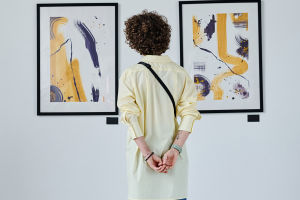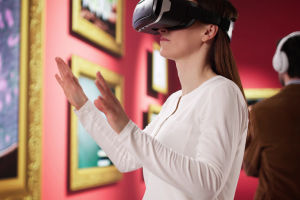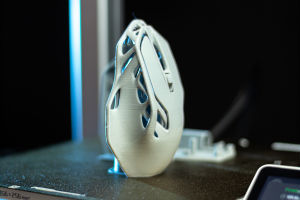Interactive Art
Art has always been a tool for expression, but over the years, it has evolved to do more than just represent an artist's vision.
Today, interactive art is revolutionizing the way we engage with creative works. Imagine stepping into a painting, or manipulating a sculpture with your own touch.
This new form of art invites viewers to become active participants, altering their experience and perception of the artwork. But what exactly makes interactive art so special, and how does it engage the audience in ways traditional art cannot?
Interactive art blends technology, creativity, and human interaction to form a dynamic and immersive experience. It's not just about observing; it's about doing. Whether it's through motion sensors, digital interfaces, or even physical interaction with installations, interactive art has made a leap from passive viewing to active participation.
What is Interactive Art?
Interactive art is a form of artwork that involves the audience as an essential element of the artistic process. Unlike traditional art forms where the viewer's role is limited to observing, interactive art invites the audience to influence or participate in the creation or presentation of the artwork itself.
The experience is often enhanced through technology, such as virtual reality, augmented reality, or motion tracking, but the core idea remains the same: engaging the viewer as a co-creator of the art.
This shift allows for personal interpretation, as each interaction with the artwork results in a unique experience. For example, a piece of interactive art might change based on where you stand, what you touch, or even the sound you make. The viewer isn't just observing; they are altering the artwork's very essence.
Blurring the Boundaries Between Artist and Viewer
One of the most compelling aspects of interactive art is the breakdown of the traditional boundary between the artist and the viewer. In most art forms, the artist creates a static piece, and the viewer is left to interpret it in their own way. With interactive art, the audience is no longer a passive observer; they are part of the creation itself.
This collaboration opens up new avenues for expression, as the art changes based on the viewer's actions, emotions, and reactions. It challenges the conventional roles of artist and audience, encouraging a dialogue where both are equally invested in the experience.
Technology's Role in Interactive Art
Technology has played a pivotal role in the rise of interactive art. From motion sensors to touch screens and immersive virtual environments, the integration of digital tools has expanded the possibilities for artistic expression.
For instance, artists now use projection mapping to create immersive experiences, where the viewer's movements can change the appearance of an installation in real-time.
Another popular tool in interactive art is augmented reality (AR), which overlays digital elements onto the physical world through the use of smartphones or AR glasses. This technology allows for an enhanced experience that bridges the gap between the virtual and real worlds.
Examples of Interactive Art Installations
Interactive art is already making waves in the art world, with numerous renowned installations captivating audiences across the globe. Take, for example, the famous "Rain Room" by Random International, where visitors walk through a room of falling water that stops when they approach, allowing them to stay dry while surrounded by the rain.
Another notable piece is "The Obliteration Room" by Yayoi Kusama. This interactive installation begins as an all-white room with furniture and objects that visitors are invited to cover with colorful dot stickers. Over time, the room transforms into a vibrant explosion of color, reflecting the contributions of every visitor.
These installations not only invite viewers to participate but also create a sense of ownership and transformation, as the art evolves with each person who interacts with it.
Emotional and Psychological Impact of Interactive Art
Interactive art has the power to evoke a range of emotions in its viewers. By engaging the senses and encouraging participation, it fosters a deeper emotional connection to the artwork. The ability to manipulate or alter the piece creates a sense of empowerment and immersion, as the viewer becomes an active participant in the artistic narrative.
Studies have shown that interactive art can have a positive psychological effect, providing a sense of accomplishment and joy. It encourages curiosity and playfulness, as well as a feeling of being part of something greater than oneself. In this way, interactive art is not just about viewing art—it's about experiencing it in a profound, emotional way.
How Interactive Art Changes the Gallery Experience
Interactive art is transforming the traditional gallery or museum experience. Instead of being a space where art is strictly observed from a distance, galleries now provide environments where the audience can touch, move, and alter the artwork.
This shift is particularly evident in contemporary art institutions, where participation has become as integral as the art itself.
Incorporating interactive elements encourages a more inclusive art experience. It allows people of all ages and backgrounds to engage with art in ways that feel approachable and personal. The barriers that once existed between the audience and the artwork are now blurred, making art more accessible to a wider demographic.
The Future of Interactive Art
As technology continues to advance, the potential for interactive art grows exponentially. Virtual reality, artificial intelligence, and machine learning will likely continue to play an integral role in creating even more immersive and dynamic experiences.
Imagine walking into an art installation that adapts to your thoughts or emotions, or where the artwork evolves over time based on your personal interaction.
The future of interactive art promises a world where the line between the viewer and the artwork continues to blur, offering an ever-deepening connection between the two. With these innovations, the possibilities are endless, ensuring that the art world will continue to push boundaries and redefine the relationship between artist and audience.
Conclusion: A New Artistic Dialogue
Interactive art offers a refreshing departure from traditional artistic formats, ushering in a new era where engagement and participation are key components of the artistic experience. It empowers viewers to not only witness art but to influence it, creating a dynamic and personalized connection with the piece.
As technology continues to evolve, the future of interactive art holds limitless potential for exploring new forms of expression and connection.
Next time you encounter an interactive art installation, don't just observe—step in, touch, and become a part of the art. After all, art is meant to be experienced, and with interactive art, that experience is yours to create. How will you engage with the art next time?
Copyright © zogu 2021 - 2025. All Right Reserved.


